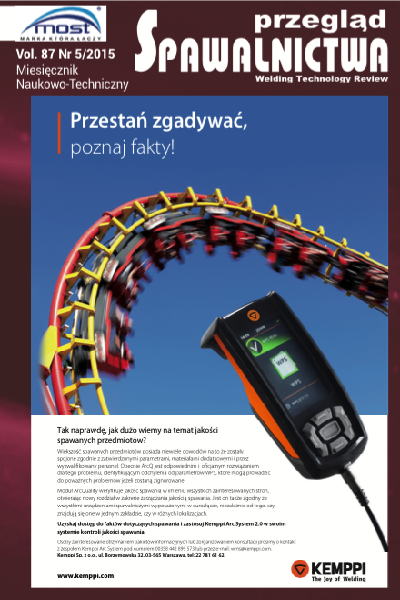Własności i struktura złączy spawanych hybrydowo HLAW (wiązka laserowa FCAW) stali obrabianej termomechanicznie S700MC
Main Article Content
Abstract
W artykule przedstawiono strukturę i własności złączy spawanych hybrydowo HLAW (wiązka laserowa FCAW) stali obrabianej termomechanicznie o wysokiej granicy plastyczności S700MC o grubości 10 mm, przy użyciu materiału dodatkowego w postaci drutu proszkowego Stein-Megafil 742 B o średnicy 1,2mm. Przeprowadzone badania nieniszczące pozwoliły sklasyfikować złącza w poziomie jakości B zgodnie z ISO 12932. Przeprowadzone badania niszczące wykazały, że złącze charakteryzuje się wytrzymałością na rozcią- ganie zbliżoną do wytrzymałości materiału rodzimego. Proces spawania hybrydowego (wiązka laserowa FCAW) stali S700MC pozwala na zapewnienie wysokich własności plastycznych złączy spawanych. W każdym obszarze złącza spawanego wartości udarności spełniają kryteria minimalnej dopuszczalnej wartości udarności. Przeprowadzone badania wykazały, że istnieje możliwość wykonania złączy spawanych, spełniających wymagania ISO 15614-14.
The properties and structure of the hybrid welded joints HLAW (laser beam FCAW) thermomechanically treated steel S700MC
Abstract
This paper presents the structure and properties of welded joints hybrid HLAW (laser beam - FCAW) thermomechanically treated steel with a high yield S700MC a thickness of 10 mm, using additional material in the form of a wire powder Stein-Megafil 742 B having a diameter of 1.2 mm. The study made it possible to classify non-destructive welded joints on the quality level B in accordance with ISO 12932. Destructive testing sho- wed that the welded joints have a tensile strength similar to the strength of the base material. Hybrid welding process (laser beam - FCAW) S700MC steel ensures the high plastic properties of welded joints. In every area of the weld joint toughness values meet the criteria for the minimum limit impact. The study showed that there is a possibility to make welded joints that meet the requirements of ISO 15614-14.
Downloads
Article Details
Creative Commons CC BY 4.0 https://creativecommons.org/licenses/by/4.0/
Welding Technology Review (WTR) articles are published open access under a CC BY licence (Creative Commons Attribution 4.0 International licence). The CC BY licence is the most open licence available and considered the industry 'gold standard' for open access; it is also preferred by many funders. This licence allows readers to copy and redistribute the material in any medium or format, and to alter, transform, or build upon the material, including for commercial use, providing the original author is credited.
References
Bagger C., Olsen F.: Review of laser hybrid welding, Journal of Laser Applications, 1/2005.
Gawrysiuk W., Siennicki M.: Robotyzacja procesu spawania hybrydowego - przykład aplikacji, Przegląd Spawalnictwa 8/2011.
Pilarczyk J., Banasik M., Dworak J., Stano S.: Spawanie hybrydowe z wykorzystaniem wiązki laserowej i łuku elektrycznego, Przegląd Spawalnic- twa 10/2007.
Messler R.: Whats Next for Hybrid Welding, Welding Journal, 3/2004.
Alam N., Kim Y. P.: Hybrid laser weldingan innovative process for high efficiency welding, Australian Welding Journal 3/2005.
Moore P. L., Howse D. S., Wallach E. R.: Development of Nd:YAG laser and laser/MAG hybrid welding for land pipeline applications, Welding and Cutting 3/2004.
Shi S., Hilton P., Mulligan S., Verhaeghe G.: Compensating for changing gap by adaptive control of the hybrid laser-MAG welding process for thick plate, Welding and Cutting 4/2005.
Murakami T., Shin M. H., Nakata K.: Effect of welding direction on weld bead formation in high power fiber laser and MAG arc hybrid welding, Transactions of JWRI 2/2010.
Nishioka K., Ichikawa K.: Progress in termomechanical control of steel plates and their commercialization, Science and Technology of Advanced Materials, vol. 13, No. 2, April 2012, pp. 1-20.
Chen B., Yu H.: Hot ductility behaviour of V-N and V-Nb microalloyed ste- els, International Journal of Minerals, Metallurgy and Materials, vol. 19, No. 6, June 2012, p. 525.
Lee, H. Shin, K. Park: Evaluation of high strength TMCP steel weld for use in cold regions, Journal of Constructional Steel Research 74 (2012) pp. 134139.
Górka J.: Influence of welding thermal cycling on the join properties of S700MC steel treated using thermomechanical method, 15th Interna- tional Conference on Experimental Mechanics, 22-27 June 2012, Porto, Portugal, pp. 197-198.
Lisiecki A.: Diode laser welding of high yield steel. Proc. of SPIE Vol. 8703, Laser Technology 2012: Applications of Lasers, 87030S (January 22, 2013), DOI: 10.1117/12.2013429.
Adamczyk J., Opiela M.: Influence of the thermo-mechanical treatment parameters on the inhomogeneity of the austenite structure and mecha- nical properties of the Cr-Mo steel with Nb, Ti and B microadditions, Journal of Materials Processing Technology, vol. 157-158, 2004, pp. 456-461.
Górka J.: Własności i struktura złączy spawanych stali obrabianej termomechanicznie o wysokiej granicy plastyczności, Wydawnictwo Politech- niki Śląskiej, Gliwice 2013.
Grajcar A., Różański M., Stano S.: Effect of heat input on microstructure and hardness distribution of laser welded Si-Al TRIP-type steel, Advances Material Science Engineering. 2014, Article ID 658947, pp. 1-8.
